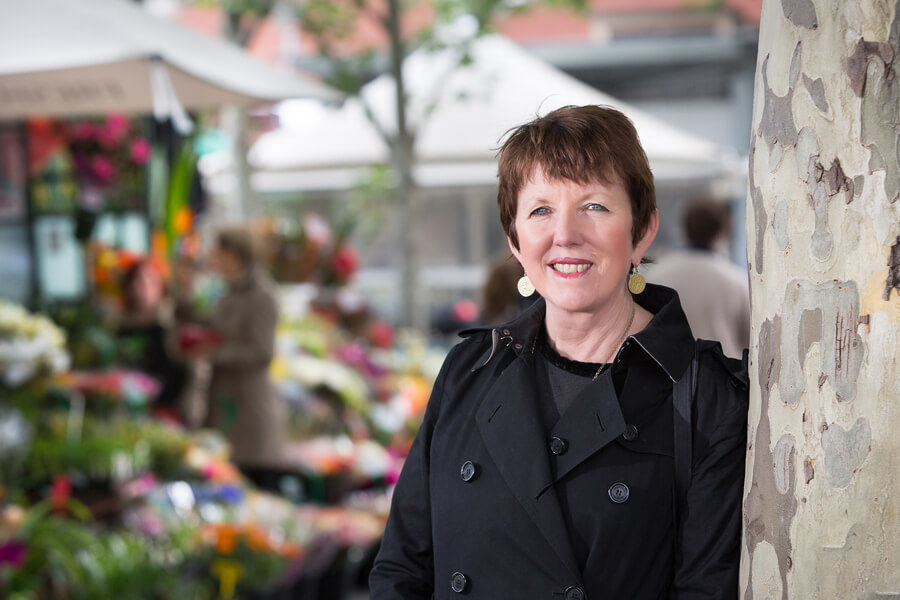A career that captured the imagination

DATE
TYPE Prevention Centre News
In December 1972, I started my first full-time job as the ‘Outside’ girl for Justin Seward & Co, a major property developer in Perth at the time. Yes – you do the math – this was 50 years ago this year, and I was 16. This job, located on the Terrace in the heart of the city, was a big deal for a working-class girl from Midvale. The surroundings were somewhat overwhelming and very unfamiliar. As I sat in reception, nervously waiting to meet with my new boss Brian Lee, a man – who I later came to know as one of the salesmen, Alan Jones blustered into reception to bemoan – to anyone who would listen – the election of Australia’s first labor government in 23 years, and to speculate on the negative impacts this would have on the development industry. The sky was falling in…
I listened curiously and a little puzzled. I suddenly became aware I had entered uncharted territory, that I would need to navigate carefully. This was a very different narrative to what I had been listening to around the kitchen table the night before, in my working-class home and neighbourhood. The election of the Whitlam Government was a cause for great excitement and anticipation. Indeed, it was beyond my wildest imaginings, what the reality of the policies of the Whitlam government would mean for me personally, as a working-class young woman. The impact was profound. Whitlam committed to promoting equality, to ‘liberate the talents and uplift the horizons of the Australian people’. Apart from the Whitlam government’s policies to support women, for me personally, the most important policy that changed the course of my life was its policies on education: Education was seen as a public good that would help Australians realise their full potential. In 1974, the Whitlam government abolished fees for tertiary education and established the Tertiary Education Assistance Scheme. For me, and many other Australians, these policies were transformative.
Once I was given the opportunity to learn, I found it intoxicating – I became a very passionate mature-aged student.
After almost a decade of national and international travel adventures, in 1982 I committed to completing an undergraduate degree (despite an attractive offer from my then boss – Banque Paribas Manager Jean Boucelot, to move with him from Bahrain where we worked together, to Panama to train as a banker). By 1992 I commenced my academic career. I relocated back to Perth from Canberra where I had been the National Education Manager for the Heart Foundation, to take up a position at UWA evaluating Healthway – the Western Australian Health Promotion Foundation, with the aim of commencing a PhD with social marketing guru, Professor Rob Donovan.
I commenced a PhD the following year in 1993, which I completed over five years while working full-time doing research on a project unrelated to my PhD and teaching. For my PhD, I chose what I thought was an exciting topic, that in fact, helped create a new field of built environment and active living research. The World Health Organization had released the Ottawa Charter in 1986, which included goals for health promotion to guide the Member States: One was to create supportive environments and the other was to create healthy public policy: these goals captured my imagination. I had worked in market research monitoring the beer market nationally and had seen how difficult it is to change people’s behaviour. I knew that a commercial company was ecstatic when it achieved a 1% market share; but the task of promoting health was way more complicated: often people did not want to ‘buy’ your product (i.e., to give up smoking, to be physically active) and in public health, we wanted to change the whole population – a 1% market share was not enough: hence bringing about structural reform that would make ‘healthy choices, the easy choices’ – as was the mantra of the day – was appealing, although there was little evidence around at the time. So I embarked on a journey to explore how the built environment affects health and wellbeing. In 2002, 20 years ago this year, I won a fellowship grant that enabled me to do research full-time for the first time in my most recent academic career. And the rest – as they say – is history. It’s been an exciting journey and a career that I have genuinely loved, which has – and still – captures my imagination.
Nothing is more exciting than the discovery of knowledge. However, as a late starter, it was not enough for me to just work on exciting research. I wanted my research to make a difference – it had to have purpose. I wanted to work on research questions that I felt were exciting, which were also important with the potential for impact.
This meant it was essential for me to work with policy and practice partners and to understand my research questions from their perspective. I have been so fortunate to work with committed policy makers and practitioners, who have taught me so much, and given me insights into the challenges of their worlds. I have come to understand that to achieve my goal of making a difference, I needed to slightly shift the dial on my team’s research, to ensure it aligned with their needs: it wasn’t hard to do, and it has been so rewarding working with you all. I’m proud of the fact that my team’s research has had so much impact, particularly in recent years.
However, none of this is possible without people. For three decades, I have had the privilege of working with a host of talented team members, collaborators and students. I am very proud of the fact that in December this year – my 24th post-doctoral year – my 23 and 24th PhD students will graduate (Afshin Jafari and Alex Kleeman), and next year in my 25th post-doctoral year, my 25th PhD student – Carl Higgs – will finish his PhD– no pressure Carl.
To each of my current and former team members, collaborators and students, I am very grateful. Together we have achieved so much, and from each and every one of you, I have learnt so much. There is a saying that we are not independent – we are interdependent. Unquestionably in this complex world of research and in particular, interdisciplinary research in which we find ourselves, this is very true.
However, to be successful also requires patronage – colleagues and other people who give one a break. In my own case, I have had many: Mr Hammond, my boss when a legal secretary, who supported my ambition to achieve a degree, by offering me a secretarial job one day a week throughout my undergraduate degree; Dallas English – then at UWA – who invited me to be a co-investigator on an NHMRC grant well before I had a PhD; Matt Knuiman and Konrad Jamrozik who agreed to be co-investigators on my first NHMRC grant and fronted with me shoulder-to-shoulder when interviewed by a formidable interview panel; Iain Butterworth who enabled me to make a difference in Melbourne, by introducing me to state and local government policymakers and providing me with access to a planner – Steph David – to help me understand the planning system in Melbourne. Through my work with Iain, I met Peter Seamer who graciously agreed to chair my NHMRC Centre of Excellence in Healthy Liveable Communities, which included Mike Day who I had known and worked with for decades – an incredible champion of our team’s work to industry. One never forgets this patronage – acts of sponsorship and kindness that has enabled my career.
Without question, my career has been a privilege. A privilege to work with great partners and extraordinarly talented people, working on research with real purpose – and even more so, as we confront the challenges that lay ahead in cities. None of this is possible without funding. Throughout my entire academic career, I have been generously supported first by Healthway – the Western Australian Health Promotion Foundation (which funded cutting-edge built environment research that other more conservative funders would not consider), the Heart Foundation which co-funded my first fellowship, the NHMRC including a capacity building grant that established UWA’s Centre for the Built Environment and Health, a Centre for Research Excellence and 17 years funding as an NHMRC Research Fellow, and more recently, when I came to Melbourne, VicHealth, CAUL and The Australian Prevention Partnership Centre. I am thrilled that only recently a new Australian Government field of research code was established for Urban Planning and Health. After years of being on the margins, a small win, we finally have our own code.
However, I am particularly grateful to RMIT for the support it has given me and my team over the last six years: the impact we have had in Melbourne, nationally and globally is completely aligned with RMIT’s ambition for its research to have impact and to serve the needs of others. However, this success would not have been possible without RMIT’s funding, and I am grateful to Calum Drummond and Swee Mak for their support over the last six years.
In closing, I want to leave you with a quote from a student’s assessment of my teaching. I found it amusing. It made me smile, so I framed and displayed this comment in my office. When asked about the best thing about the teaching of Billie Giles-Corti, this student wrote ‘She tried to make it interesting.’ So, as I leave the career that I have loved so much and look to an exciting future if I hear any of you say ‘She tried to make a difference’ – I will be satisfied and it will make me smile, because indeed that has been the driving force behind my career – to try to make a difference. I will always be grateful to the Whitlam government’s education policies. Through Gough Whitlam’s ambition and vision for Australia, my horizons were indeed uplifted, and the opportunities I have been afforded, I could never have imagined.



